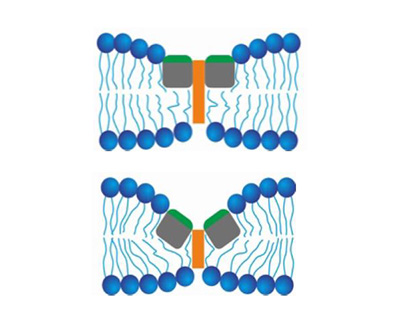
Top: Fusion peptides bind to the inner surface of the vacuole membrane. Bottom: The fusion peptides bind to each other, tilting and pinching the inner and outer surface of the membrane together, forming a hole. Credit: NIH
To infect a cell, enveloped viruses such as influenza virus employ spike proteins on the viral surface. When activated, these proteins—spearheaded by a segment known as the fusion peptide—interact with proteins on the cell’s outer membrane. Next, the cell membrane envelops the virus in a pocket-like structure called a vacuole, which takes the virus inside the cell.
Through a series of experiments, computer simulations, and mathematical models, researchers from the Zimmerberg Lab and colleagues investigated the sequence of events occurring after the vacuole takes the virus into the cell.
They found that the spike protein’s fusion peptides bind to the vacuole’s membrane, which is composed of two layers of lipids (fats). The fusion peptides bind to the inner lipid layer, and adjacent peptides bind to each other. The attraction of the fusion peptides pulls membrane proteins together and pushes away the fats, thinning the membrane at the binding site. A rocking motion of the peptides penetrates the outer layer of the membrane, thinning the spot to the point of breaking, as the action pinches the inner and outer lipid layers together. Ultimately, this creates a hole in the vacuole’s membrane, allowing the virus to deliver its genetic information into the cell.
The findings help explain why so many viruses make holes in their target membranes, why the fusion machinery of influenza variants typically does not mutate, and how spike proteins allow viral genetic material to enter the cell. These insights may inform the development of new technologies to combat infectious microbes and to insert medications, genes, and proteins into cells to treat various diseases.
Learn more about the Physical Biology and Medicine Group: https://www.nichd.nih.gov/about/org/dir/affinity-groups/PBM
 BACK TO TOP
BACK TO TOP